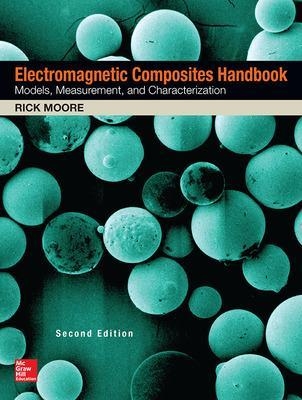
Electromagnetic Composites Handbook, Second Edition
McGraw-Hill Education (Verlag)
978-1-259-58504-3 (ISBN)
- Titel z.Zt. nicht lieferbar
- Versandkostenfrei innerhalb Deutschlands
- Auch auf Rechnung
- Verfügbarkeit in der Filiale vor Ort prüfen
- Artikel merken
Publisher's Note: Products purchased from Third Party sellers are not guaranteed by the publisher for quality, authenticity, or access to any online entitlements included with the product.
Electromagnetic Composites Data, Principles, and Applications
This fully revised engineering and scientific handbook offers complete coverage of electromagnetic modeling and explains the characterization of composite materials from the theoretical, computational, and experimental points of view. The book extends the von Hippel text to include data on additional non-conducting dielectrics; semiconducting, conducting, and magnetic materials; and composites composed of two or more molecularly distinct compounds that range in size from nanometers to centimeters. Electromagnetic Composites Handbook: Models, Measurement, and Characterization, Second Edition, simplifies the development of multifunctional material designs and includes tabulated data for more than 300 materials.
This updated edition covers:
Wave Equations and Electromagnetic Constitutive Parameters
Sources and Dispersion for Polarization and Permittivity
Sources and Dispersion of Magnetization and Permeability
Fundamental Observables for Material Measurement
Composites and Effective Medium Theories
Conducting-Dielectric and Magneto-Dielectric Composites
Numerical Models of Composites
Electromagnetic Measurement Systems Summary for RF – Millimeter Wavelengths
Resonant Techniques for Material Characterization
Transmission Line, Free Space Focused Beam and TE10N Measurement Details
Micron and Nano Scale Composites
Rick Moore received his PhD in Physics in 1978 and has performed and coordinated research, development, and engineering at the Georgia Institute of Technology Research Institute. His work is documented in approximately 150 articles, presentations, patents, and reports.
Introduction
Outline
References
Chapter 1. Introduction to Wave Equations and Electromagnetic Constitutive Parameters
1.1 Maxwell’s Equations and Field Sources
1.2 Permittivity and Charge
1.3 Permeability and Current
1.4 Wave Equations for Homogeneous and Inhomogeneous Materials
1.5 Homogeneous Propagation in Linear Media
1.6 Conclusion
References
Chapter 2. Sources and Dispersion for Polarization and Permittivity ε(f)
2.1 Sources of Permittivity, Resistivity, and Conductivity in Materials
2.2 Modeling Material Complex Permittivity and Its Frequency Dependence
2.3 Small Damping, τ ⇒ 0
2.4 DC, Zero Frequency, and DC Scaled Permittivity
2.5 Combined Models for Permittivity
2.6 Coupling Permittivity and Permeability
2.7 Additional Bound Charge Contributions to Permittivity and Frequency Dispersion
2.8 Permittivity Variation with Temperature
References
Chapter 3. Sources and Dispersion of Magnetization and Permeability μ(f)
3.1 Sources of Permeability
3.2 Frequency Dispersion in Magnetic Materials
3.3 Susceptibility Models for Data Analysis
3.4 An Overview of Micromagnetic Models
3.5 Kramers–Kronig (KK) Relationships
3.6 Temperature-Dependent Permeability
References
Chapter 4. Fundamental Observables for Material Measurement
4.1 Introduction
4.2 Scattering of Plane Waves from Homogeneous Planar Boundaries and Material Slabs
4.3 Single Planar Slab of Material
4.4 Scattering: Cascade Matrix Method for Multi-Boundary Material Analysis
4.5 Scattering from a Shunt Planar Impedance Sheet
4.6 Transmission and Reflection from Anisotropic Laminates
4.7 A Numerical Anisotropic Material Example
4.8 Conclusion
References
Chapter 5. Composites and Effective Medium Theories
5.1 Introduction
5.2 EMT Development Timeline
5.3 Limitations and Derivation of EMTs
5.4 Scattering Functions for Spheres
5.5 Scattering and EMT of Large–Aspect Ratio Particle Geometries
5.6 Layered Inclusions
5.7 Model Choices: Importance of Conduction and Particulate Interaction
References
Chapter 6. Conducting-Dielectric and Magneto-Dielectric Composites
6.1 Introduction
6.2 Percolation, Dimensionality, Depolarization, and Frequency Dispersion in Semiconducting, Conducting-Dielectric Composites
6.3 Magnetic Effective Media
References
Chapter 7. Numerical Models of Composites
7.1 Method of Moment Modeling and Laminated Composites
7.2 Finite Difference Time Domain Simulations
7.3 Comments for Chapters 5 to 7
References
Chapter 8. Electromagnetic Measurement Systems Summary for RF–Millimeter Wavelengths
8.1 An Introduction to Wideband Material Metrology
8.2 Error Correction, Calibration, and Causality
8.3 Historical: Von Hippel and the Slotted Line
8.4 Summary of Measurement Techniques
8.5 Nonresonant Techniques: General Transmission Line Measurement Guidelines and Procedures
8.6 Cylindrical Waveguide
8.7 Coaxial Lines
8.8 Stripline Measurements
8.9 Focused Beam Free Space System
8.10 Focused Beam Technical Description
8.11 Calibration, Measurements, and Discussion
References
Chapter 9. Resonant Techniques for Material Characterization
9.1 Resonant Cavities
9.2 Overview of the TE10p Measurement Technique
9.3 Parallel Plate Stripline (TEM) Cavity
9.4 Closed Reflection Cavity
9.5 Open Cavity: Fabry–Perot Resonator
References
Chapter 10. Transmission Line, Free Space Focused Beam and TE10N Measurement Details
10.1 Constitutive Parameter Solutions in Coaxial Transmission Line, Rectangular Waveguide, and Free Space
10.2 Extreme Elevated Temperature Reflection Measurements
10.3 Free Space Focused Beam Characterization of Materials
10.4 TE10N Transmission Cavity
References
Chapter 11. Micrometer and Nanoscale Composites
11.1 Applications and Impetus for Nano Magnetic Composites
11.2 Case Study 1: NiZn and MnZn Ferrites
11.3 Case Study 2: Nano Magnetic Composites
11.4 Case Study 3: Multiscale EMT (Nano to Macro) for Artificial Dielectrics
11.5 Conclusions
References
Chapter 12. Measured Data of Materials and Composites
12.1 Solid Ceramic versus Frequency
12.2 Solid Ceramic versus Temperature
12.3 Ceramic Fiber versus Temperature
12.4 Two-Phase Ferrite-Polymer Composites and Three-Phase Ferrite-Fe-Polymer Composites
12.5 Composites Demonstrating Percolation
12.6 Solid Semiconductors versus Frequency
12.7 Honeycomb and Foams versus Frequency
12.8 Polymers versus Frequency
12.9 R-Cards versus Frequency
12.10 Micrometer and Nanometer Magnetite Magnetic Composites versus Frequency
12.11 Iron–Polymer Composites versus Frequency
12.12 Ceramic Polymer Fiber versus Frequency
12.13 Dense Ferrites versus Frequency
12.14 Fiber–Polymer Composites versus Frequency
Index
| Erscheinungsdatum | 05.04.2016 |
|---|---|
| Verlagsort | OH |
| Sprache | englisch |
| Maße | 203 x 239 mm |
| Gewicht | 930 g |
| Themenwelt | Technik ► Elektrotechnik / Energietechnik |
| Technik ► Maschinenbau | |
| ISBN-10 | 1-259-58504-2 / 1259585042 |
| ISBN-13 | 978-1-259-58504-3 / 9781259585043 |
| Zustand | Neuware |
| Haben Sie eine Frage zum Produkt? |
aus dem Bereich


